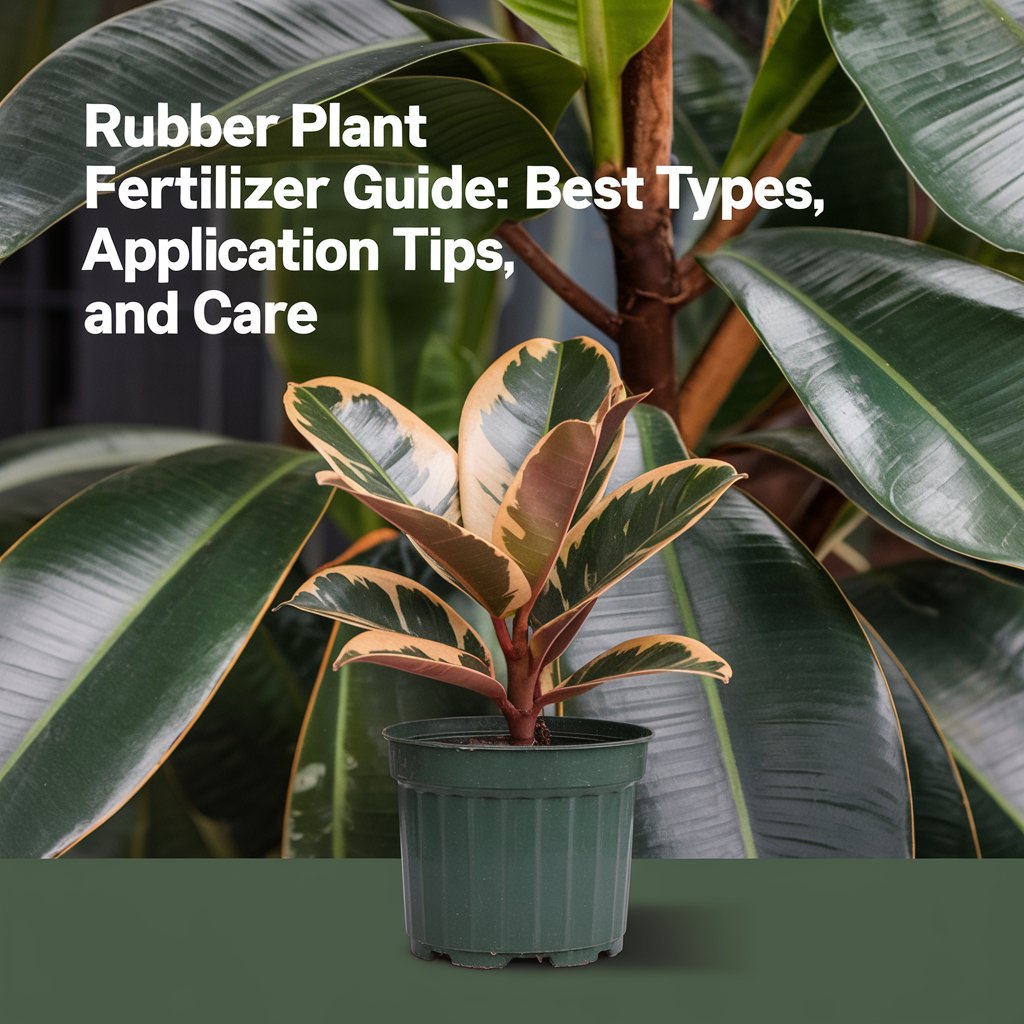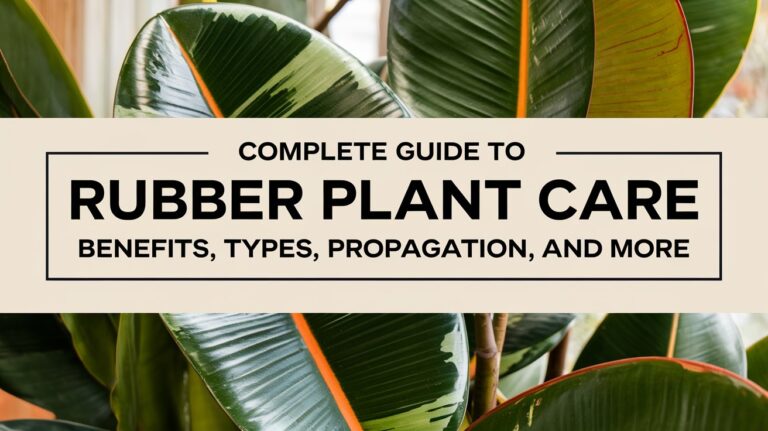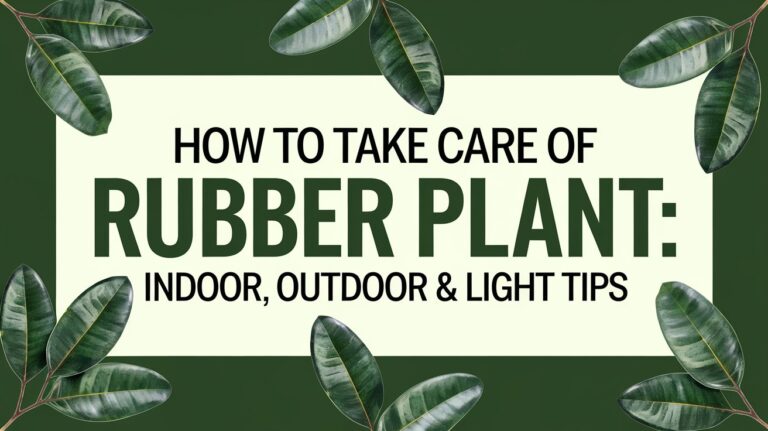Rubber Plants (Ficus elastica) are a staple for indoor plant lovers. With their glossy, rich-green leaves and ability to thrive in various conditions, they make a statement in any home. However, like any plant, they need proper care to grow healthy and lush. One often-overlooked aspect of care is fertilization. In this guide, I’ll share my personal experience and tips on choosing the best fertilizer for Rubber Plant, proper fertilizer application for Rubber Plant, and how to maintain their health year-round.
Why Rubber Plants Need Fertilizer
When I first started growing Rubber Plants, I didn’t think much about fertilizers. But over time, I noticed slower growth, yellowing leaves, and a lack of that vibrant green luster. That’s when I learned the importance of feeding your plants.
Rubber Plants, like most houseplants, rely on nutrients from the soil. Over time, these nutrients deplete, especially in potted plants. Adding the right Rubber Plant fertilizer replenishes these nutrients and keeps your plant thriving. Proper fertilization encourages healthy foliage, robust growth, and resilience against common plant issues.
Best Fertilizers for Rubber Plants
Choosing the right fertilizer is key. Through trial and error, I’ve discovered a few types that work wonders:
1. Liquid Fertilizers
Liquid fertilizers are my go-to for their convenience and quick absorption. Look for an all-purpose fertilizer with a balanced NPK ratio, like 10-10-10 or 20-20-20. These provide the essential nitrogen, phosphorus, and potassium that Rubber Plants need.
2. Slow-Release Fertilizers
If you’re like me and sometimes forget your fertilization schedule, slow-release pellets are a lifesaver. They gradually release nutrients over time, making them perfect for low-maintenance care.
3. Organic Fertilizers
For a more natural approach, I recommend organic options like compost tea, worm castings, or seaweed extract. These improve soil health while feeding your plant.
4. Specialized Houseplant Fertilizers
If you’re looking for something tailored, many brands offer fertilizers specifically for indoor plants. These are often gentle and ideal for regular feeding.
When and How Often to Fertilize a Rubber Plant
One of the first questions I had was, “How often should I fertilize my Rubber Plant?” It turns out, timing is everything.
Seasonal Feeding Schedule
- Spring and Summer: During the growing season, fertilize every 2-4 weeks. Rubber Plants are actively growing and need a steady supply of nutrients.
- Fall and Winter: As growth slows, reduce or stop fertilization. Over-fertilizing during dormancy can harm your plant.
Signs Your Rubber Plant Needs Fertilizer
If you notice pale leaves, stunted growth, or your plant looking less vibrant, it might be time to add a dose of Rubber Plant fertilizer.
How to Apply Fertilizer to Rubber Plants
Proper application is just as important as the type of fertilizer you use. Here’s my tried-and-true method for fertilizer application for Rubber Plant:
- Dilute Liquid Fertilizer
Always dilute liquid fertilizers to half the recommended strength to avoid burning the roots. I mix mine with water and use it as part of my regular watering routine. - Apply Slow-Release Fertilizer
Scatter the pellets evenly on the soil surface and water thoroughly to activate. - Water Before Fertilizing
Never apply fertilizer to dry soil. Water your plant first to prevent fertilizer burn. - Flush the Soil Periodically
Over time, salts from synthetic fertilizers can build up in the soil. Flush the pot with water every few months to prevent this.
Caring for Rubber Plants with Fertilizer
Fertilizing is just one piece of the puzzle. Here are some additional tips to complement your fertilization routine:
- Light: Ensure your Rubber Plant gets bright, indirect light. Proper lighting helps the plant utilize the nutrients from the fertilizer.
- Watering: Keep the soil evenly moist but not soggy. Overwatering can lead to root rot, which no amount of fertilization can fix.
- Pruning: Regularly trim yellow or damaged leaves to keep your plant healthy and allow nutrients to focus on new growth.
Common Mistakes with Rubber Plant Fertilizer
I’ve made my share of mistakes, and here’s what I’ve learned to avoid:
- Over-Fertilizing
More isn’t always better. Over-fertilizing can cause leaf burn and stress the plant. Always follow the recommended guidelines. - Using the Wrong Fertilizer
Not all fertilizers are created equal. Avoid those with high nitrogen content designed for lawns, as they can promote excessive, weak growth. - Fertilizing During Dormancy
Rubber Plants need less during the cooler months. Fertilizing during this period can disrupt their natural cycle.
Benefits of Proper Fertilization
When I started using the right Rubber Plant fertilizer, the difference was incredible. My plant’s leaves became more vibrant, the growth was faster, and it looked healthier overall. Fertilization not only supports your plant’s aesthetic but also strengthens its resistance to pests and diseases.
FAQs About Rubber Plant Fertilization
- What is the best fertilizer for Rubber Plant?
A balanced liquid fertilizer (10-10-10 or 20-20-20) works best. Slow-release or organic options are also excellent. - How often should I fertilize my Rubber Plant?
Fertilize every 2-4 weeks during spring and summer, and reduce or stop during fall and winter. - Can I use organic fertilizer for Rubber Plants?
Yes! Organic fertilizers like compost tea or worm castings are great for Rubber Plants. - Do Rubber Plants need fertilizer indoors?
Absolutely. Potted plants rely on regular feeding to replace depleted nutrients in the soil. - What happens if I over-fertilize my Rubber Plant?
Over-fertilization can cause leaf burn, yellowing, and salt buildup in the soil. Flush the soil and reduce fertilization if this happens.
Conclusion
Fertilizing your Rubber Plant is essential for maintaining its health and beauty. By choosing the best fertilizer for Rubber Plant and following proper fertilizer application for Rubber Plant, you’ll ensure lush, vibrant foliage and steady growth. Remember, a little care for rubber plants goes a long way. With the right approach, your Rubber Plant will reward you with years of stunning greenery.
Give it a try, and let me know how it goes! 😊
Hi, I’m Pritesh, the heart and hands behind Roots & Earth. My love for plants started when I was just 5 years old, planting trees alongside my grandfather. Those early experiences in the garden left a lasting impression, shaping my deep connection to nature and sparking a lifelong passion for nurturing green spaces.
With an MBA under my belt, I’ve blended my business acumen with my love for gardening, creating Roots & Earth as a way to share my knowledge and inspire others. When I’m not working in my own home garden, you’ll find me traveling to the mountains—my favorite getaway for reconnecting with the natural world.
At Roots & Earth, I’m here to guide you on your gardening journey, whether you’re a seasoned green thumb or just starting out. Together, let’s cultivate beautiful, thriving spaces that enrich our lives and the earth.




